
by Kaye Dee
Today is C-Day (Conversion Day) – the day Australia switches to decimal currency after 140 years of using the British system of Pounds, Shillings and Pence. (I actually think it should have been called D-Day, for Decimalisation Day, but I guess that might have seemed insensitive to some of our returned servicemen). Schoolkids are now sighing with relief that they will not have to learn to do those complicated “money sums” like all the generations before them!
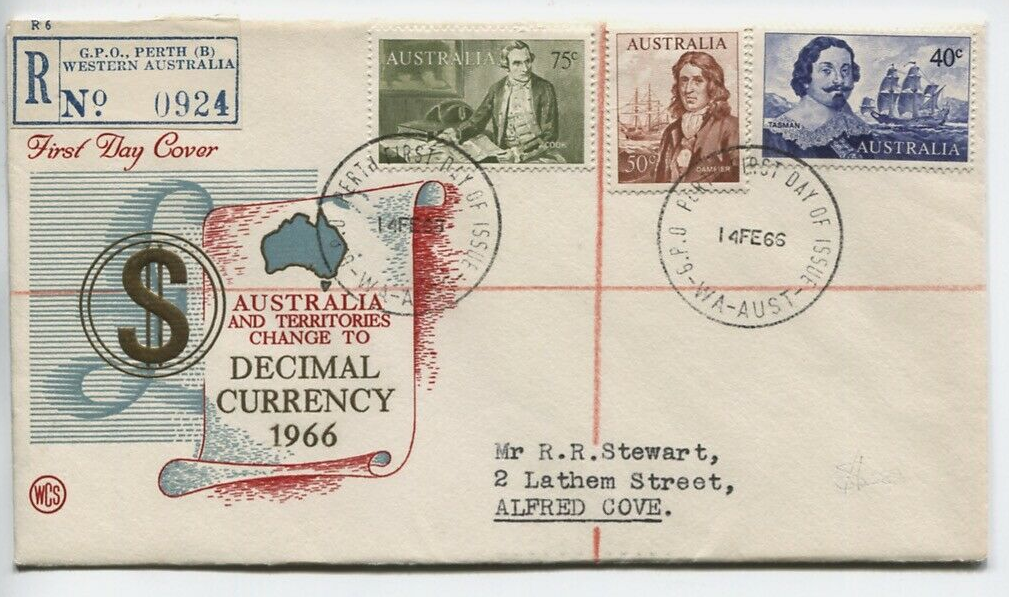
A Rum Deal
Australia’s monetary history is rather colourful. In the early days of the penal colony in Sydney, there was very little hard currency available, and most transactions were by barter. Rum and other spirits became a form of currency, controlled by corrupt military officers, which earned their regiment the nickname “the Rum Corps”. When Governor Bligh (yes, that Bligh of Mutiny on the Bounty fame!) tried to prohibit spirits from being used as a medium of exchange, it resulted in a mutiny that drove him from the colony in 1808. This event is known, not surprisingly, as the Rum Rebellion.


Governor Macquarie, Bligh’s successor, introduced the first Australian currency. He purchased 40,000 Spanish dollars and had a round piece punched out of the middle of each one, producing two coins – the “holey dollar” (valued at five shillings) and the “dump” (valued at one shilling and three pence). His “minter” was a convicted forger!
Real Money
In the mid-1820s, the British Government finally decided to provide the Australian colonies with a proper currency and introduced the British system of Pounds, Shillings and Pence. If you’re not familiar with it, 12 pence (pennies) made up a shilling and 20 shillings made one pound.
Australia used British coins and banknotes right up into the early 1900s. It wasn’t until 1910, nine years after the colonies federated to form the Commonwealth of Australia, that the Australian Pound was introduced. Even then, it was branches of Britain’s Royal Mint in Sydney, Melbourne and Perth that produced the coins, indicating how closely Australia remained tied to Britain. The first Royal Australian Mint was only opened in early 1965 to produce our new decimal coins.


Australian Pound notes (with pretty boring designs) and the full range of Australian coins available before the changeover to decimal currency. A "florin" was another name for a two shilling coin
Going Decimal
Several times in the past 50 years, there have been suggestions for Australia to adopt a decimal currency system. Decimal currency puts us in line with all the world’s major currencies, apart from the Pound Sterling, and all our trading partners apart from Great Britain. But Britain did not want Australia to change its monetary system, and successive Australian Governments and the Reserve Bank of Australia ultimately accepted the British view.
However, in the late 1950s, Prime Minister Robert Menzies finally recognised the economic and pragmatic importance of converting to a decimalised currency. With Australia’s export trade increasing, the complexity of the Pounds, Shillings and Pence system made the arithmetic of financial transactions unnecessarily difficult (as I know from personal experience). Research showed that decimalisation would save the Australian economy more than £11 million ($22 million) a year, through the increased convenience of a decimal currency. This would quickly offset the £30 million ($60 million) cost of conversion. So, in 1963 the Currency Act nominated 14 February 1966 as the day Australia would go decimal.
In Come the Dollars…
Our new currency needed a name and new designs that would be uniquely Australian. A public competition was held in 1963 to find a name “with an Australian flavour” for the currency. About 1000 submissions were received. These included suggestions such as Austral, Boomer (a male kangaroo), Kanga, Roo, Emu, Digger (an Australian soldier), Zac (old nickname for a sixpence coin; it’s also slang for something worthless), Kwid (a funny spelling of the old slang “quid” meaning a Pound), and Ming (from Prime Minister Menzies’ nickname, which comes from the Flash Gordon character “Ming the Merciless”!).

1963 prototype designs for the possible new "Royal". As you can see, one design followed the style of the existing Pound note, the other was quite modern and tilts towards the style in the eventual dollar design
Mr. Menzies rejected all the competition’s suggestions. Being a fervent monarchist, he proposed instead calling the currency the Royal. However, the public made it clear that they didn’t like that name (I certainly didn’t!), so in September 1963, the Treasurer announced that our new currency would be the dollar (which would be the equivalent of 10 shillings), divided into 100 cents. Everyone was much happier with that.
Monopoly Money
It was decided that the new coins should depict Australian wildlife while the notes should reflect national history and Australia’s contribution to the wider world. Gordon Andrews, one of Australia’s leading industrial designers, has designed the new notes. His bright colours and modern style have already led to some wits comparing the new notes to “Monopoly money”, but I think they look great and represent a nation which is coming out from under Britain’s shadow and finding its own feet.
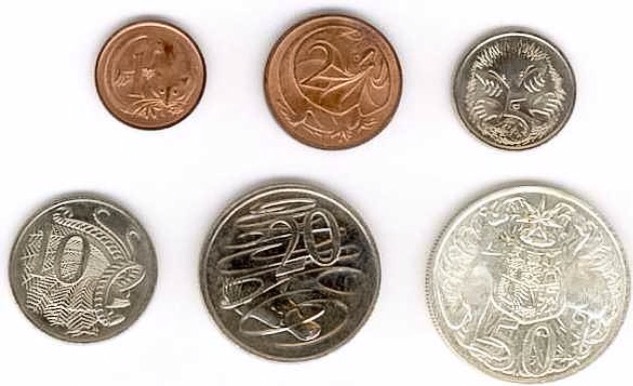
Australia's new decimal coins. The 1 cent piece shows a possum (a completely different animal from the American opossum); the 2 cent, a frill-necked lizard; the 5 cent coin shows an echidna (otherwise known as a spiny ant-eater) and the 10 cent a lyre-bird; the 20 cent depicts a platypus and the 50 cent coin carries the Australian Coat of Arms, which includes a kangaroo and an emu
The $1 note acknowledges Australia’s origins depicting Aboriginal art and Queen Elizabeth II, while the $2 highlights Australian agricultural innovation in the development of the superfine wool Australian Merino sheep and rust-disease resistant Federation wheat. The $10 note recognises the freed convicts who helped to build this country and our home-grown poets and writers, and the $20 celebrates internationally renowned Australian aviation pioneers. I understand that next year, once we have become more used to the new notes, a $5 bill will also be introduced. Hopefully, it will recognise the often-overlooked contribution of women to Australia’s history.
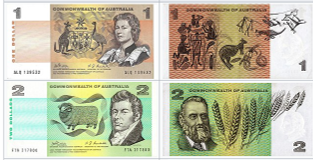
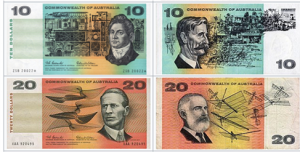
Our new dollar notes, with their fresh modern styling. To make the transition easier for users, the decimal notes have been matched to their counterparts in the “old money” and are similarly, but more brightly, coloured as you can see by comparison with the earlier image of the Australian Pounds
Meet Dollar Bill
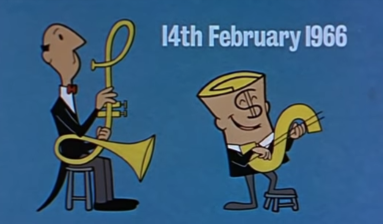
Dollar Bill, the decimal changeover mascot, singing his jingle to a classical musician playing an instrument shaped like the Pound symbol
In April last year, a new character appeared on our TV screens and in cinema ads. His name is “Dollar Bill” and he was introduced as part of the government’s campaign to educate everyone about decimal currency before C-Day arrived. Dollar Bill has been on TV every night (sometimes too many times a night!), singing his catchy little jingle to help familiarise people with the new currency values and the date of changeover. The most memorable part of the jingle is: “In come the dollars and in come the cents, to replace the pounds and the shillings and the pence. Be prepared folks when the coins begin to mix, on the fourteenth of February 1966”. I’m not sure why, but the identity of the person who provides the voice for Dollar Bill is being kept a secret.
The jingle’s tune is based on the folk song “Click Go the Shears” (about sheering sheep in outback Australia). Everyone knows that song, so it makes the decimal currency rhyme easy to remember. I think it’s engraved on my brain now: I’ve heard it so many times, I suspect I’ll still be able to sing it when I’m sixty! Those of you in America might be interested to know that the tune was originally an American Civil War song "Ring the Bell, Watchman" by Henry Clay Work, that somehow made its way down under.
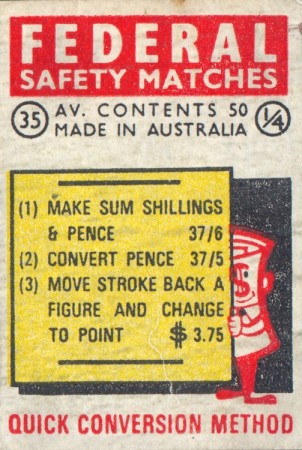
The character is very popular with kids and apparently the Decimal Currency Board gets about 500 fan mail letters a week for Dollar Bill from school children. He has appeared on everything from billboards to matchbox covers.
To appeal to the teenage audience, there’s a hip little rock number called “The Decimal Point Song”, sung by a young man named Ian Turpie. It was never going to rate on the pop charts, but I think young Turpie could have a good career ahead of him in entertainment. For older Australians there’s even a series of television ads called “Get with It, Gran”.
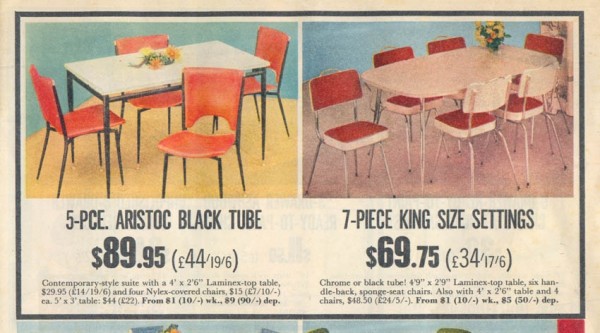
Major retailers are helping customers feel comfortable with the changeover by including decimal prices and their "old money" equivalents in their catalogues
It's not easy for older people, or younger ones either for that matter, to get used to the change, especially if they are not very good at maths. But at least we have two years of changeover, during which both old and new currency can be used. Of course, the kids now in Primary School have it easy, as they'll grow up with the new system. It will be interesting to see on the news tonight how the first day of the changeover goes, but I doubt there will be the chaos that some pessimists are predicting after all the community preparation. And who knows – if things go smoothly, maybe the government will even consider taking Australia metric as well in the future!
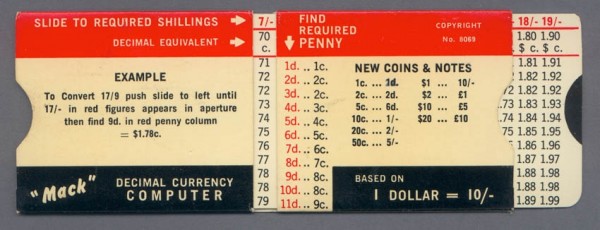
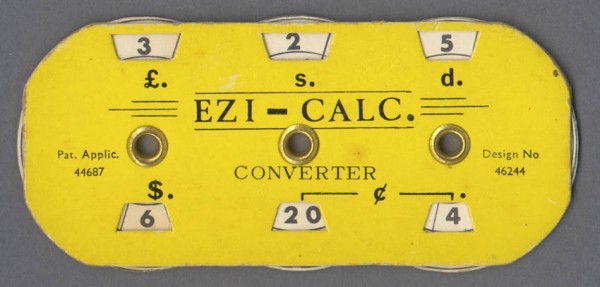
There are quite a few handy little pocket calculators like these available that make the conversion process relatively easy. I'll bet their inventors are making a small fortune

